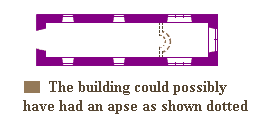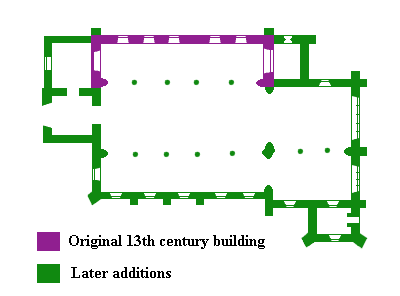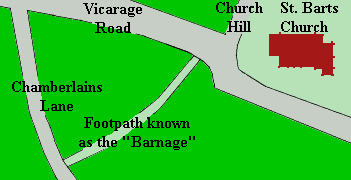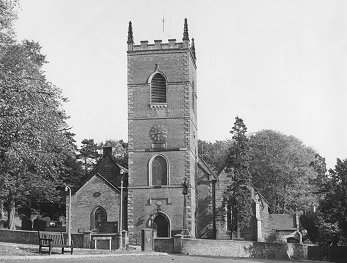|
After the Norman invasion Penn was still
heavily wooded but its character was slowly changing. The trees
were cleared by the small number of tenants who cultivated the
land and developed small farms. There were two Manors, Over Penn
and Nether Penn (Upper Penn and Lower Penn), separately governed
by their own courts that were convened by the Lord of each
Manor. Within a generation of the Domesday book Lower Penn
belonged to the Buffor or Buffery family and for a time was
known as Penn Buffor to distinguish it from Upper Penn.
| The
landowners of the Buffery family and approximate
dates of ownership were as follows: |
|
| William Buffery I |
|
Lord Thomas Buffery |
1327 - 1381 |
| William Buffery II |
1166 - 1199 |
Lord William Buffery |
1378 - 1382 |
| William Buffery |
1199 - 1227 |
John Buffery |
1412 - 1423 |
| Roger Buffery |
1253 - 1269 |
William Buffery |
1423 - 1443 |
| Robert Buffery I |
1272 - 1315 |
Joan Buffery |
1442 |
| Lord Robert Buffery II |
1323 - 1327 |
|
|
Some of the land was owned by the Burnett family and also the
Warine (de Penne) family, also called the Warin of fitz Warin.
They appear in the 12th century and were probably
related to the ancient Wolverhampton family of Waring of the
Lea.
Like Lower Penn, Upper Penn would have been cultivated by a
relatively small number of families. In 1291 there was a Penn
Wood Farm that was run by one of Henry de Bushbury’s tenants. At
the time the open-field system of farming was used. A farmer
would cultivate strips that were scattered across the open
fields and would share the common pasture with his neighbours.
There were also freeholders who had a right to use the common
land.
As time progressed the farmers might purchase their own croft
and some of the cultivated strips, but farming was strictly
under the control of the Lord of the Manor via the Manor’s
court. The court could decide what crops were planted and when
the harvest would take place and such things as the erection and
dismantling of temporary fences. If a farmer was late with the
harvest, his neighbour’s cattle could be turned onto his land to
devour what was left of the crop and his profits would be gone.
Under the feudal system that prevailed at the time, the Lords
who were the landowners of the day had to provide the King with
manpower for the army as and when required. In 1316 King Edward
II was concerned that he was not getting sufficient men from
Staffordshire to fill the ranks of the infantry for the defence
of the country. He asked William de Wrothesley to look into the
matter and contact Henry de Bushbury, Lord of Bushbury and Upper
Penn and Robert Buffery, Lord of Lower Penn.
|

| The possible layout
of St. Bartholomew's Church in the 13th century. |
|
Penn received its first church in about 1200 when
the original part of what is now St. Bartholomew’s Church was
built. After the Norman Conquest Penn was owned by
William Fitzansculph, Lord of Dudley. His tenant was Robert who
owned Bushbury, Oxley and Ettingshall. Robert's descendants
became Lords of Penn and Bushbury, and one of them, Sir Hugh de
Bushbury, built churches at both Penn and Bushbury. |
|
There is a story that the churches were
built as an act of penance after
Sir Hugh de Bushbury killed a man in a quarrel. It is
probable that this is untrue because there is no historical
record to verify it, and in about 1300 one of his descendants
was charged with the murder of the Lord of Swynnerton and later
acquitted, so the story may stem from that.
The first church could well have been a
wooden building that was later replaced by a more permanent
stone structure. The stone building occupied the northwest
corner of the present church and would have been quite small by
modern standards, about 14 metres by 7 metres. Some of the
original stonework can still be seen in the north wall of the
church and the first two pillars in the northwest part of the
nave are thought to be from that building.
In early documents the church is referred
to as the Parish Church of Penn and was possibly dedicated to
St. John. In 1533 John Smith of Lower Penn made his will in
which he requested to be buried in the churchyard of St. John
the Baptist at Upper Penn. The chief witness was Robert Jackson
who was the vicar at the time and so the information must be
correct. The earliest documentary evidence for the modern name
of St. Bartholomew dates from 1801 and it is uncertain when and
why the name was changed.
|
| When the original church was built Sir Hugh de
Bushbury gave all of the tithes in Penn as an endowment and so
the first ministers were Rectors (a tithe is one tenth of the
produce of one’s land or annual income and was paid as a
contribution to the church or clergy and a Rector was the person
who owned all of the tithes in the Parish).
The first Rector was John of Wolverhampton and a tithe barn
would probably have been built near to the church. |

| A plan of St.
Bartholomew's showing the relationship of the early
building to the modern church. |
|
|

The location of old footpath known as the
"Barnage".
|
There is still an old footpath that runs across
the field by the former vicarage to Chamberlain’s Lane that is
known as the “Barnage”.
In those days a church was not just a place of worship, it
was also a community centre. Travelling players would perform
there and some churches were used as a barn in which to store
the tithes of grain. |
|
In about 1228 Sir Hugh de Bushbury, son of
the founder of the church married his cousin. This was forbidden
by church law and in order to pacify the Bishop of Lichfield Sir
Hugh gave him the living of Penn as a bribe. This meant that all
new Rectors would be appointed by the Bishop instead of Sir
Hugh. The next vacancy for a new Rector came in 1242 when the
Bishopric was vacant. As a result King Henry III appointed Adam
Rogus, but Sir Hugh claimed that the living was still his
because the Bishop had no right to accept the bribe. The case
went to court and the judges decided in the King’s favour, and
so the appointment remained valid and future appointments were
made by the Bishop.
When the fourth Rector, Robert of Clipston
was appointed by the Bishop in 1321 the de Bushbury family again
attempted to appoint their own candidate as can be seen from the
following entry in the records at Lichfield:
“after this a certain Henry de Bushbury,
claiming to be Patron of Penn himself, had appointed the living
to someone else”.
|
Rectors of Penn: |
| 1216 |
John of Wolverhampton |
| 1242
|
Adam Rogus |
| 1292 |
Richard Walrand |
| 1315 |
Robert of Clipston. Also Cannon of
Lichfield
and Rector of Lutterworth. |
| 1321 |
William of Wykingston |
| 1344 |
Richard of Lichfield |
| 1345 |
Nicholas Teynterel |
|
Vicars of Penn to 1500: |
| 1350 |
Ralph of Sutton |
| 1353 |
John Hunt |
| 1358 |
Richard Brown |
| 1371 |
Thomas Smith |
| 1390 |
Hugo David de Clone |
| 1391 |
William Tye |
| 1392 |
William Lynchewyk |
| 1393 |
Simon Preston |
| 1404 |
John Hopkyns |
| 1454 |
John Moy |
| 1499 |
William Norlaston |
A reference to the church can be found in
the Duke of Sutherland’s 'Lord of the Manor Deeds' that relates
to an ordination that took place on 8th June, 1318.
The priest was ordained by Walter de Langton who was Bishop of
Coventry and Lichfield at the time.
“Be it known unto all men that we,
Walter, by Divine permission Bishop of Coventry and Lichfield,
on Ember Saturday in the vigil of the Holy Trinity, a.d. 1318 in
the Parish Church of Penne in our diocese did then and in that
place ordain our beloved in Christ John de Casseheo, deacon of
our diocese to a sufficient title in the priesthood with which
he reckons himself content. Whereupon we have caused these our
letters to be made patent.”
|
| There were many disputes about land in Upper and
Lower Penn. Sometimes the disputes went to court and the
resultant records give an insight into life at the time. The
records also give the names of the people involved and where
they lived. On 4th April, 1305 a case about a land
dispute was heard at the Lichfield assizes between Thomas Creye
of Crumpton against Richard Walrand, the Rector at Upper Penn
and William and Emma de Fynchenesfield (Finchhfield). The
dispute continued for many years and William and Emma featured
in a number of law suits concerning the land. |

St. Bartholomew's Church. |
|
Things really got out of hand in 1356 when
Richard de Fynchenesfield (possibly William and Emma’s son) was
charged along with Roger de Walle of NetherPenne and Henry, son
of Edward of Netherpenne of procuring William, son of Hugh de
Penne and Thomas Buffery, Lord of Netherpenne to kill John
Matheu at Whytewyk (Wightwick) within the Manor of Tettenhall.
Also in 1386 Roger Pecok, chaplain; John
son of Thomas Le Walkere of Humeley (Himley) and Roger from the
Lane at Trescott were accused of stealing goods and chattels to
the value of £20, a large sum of money at the time. They were
also accused of stealing linen, woollen cloth, brass and wooden
bowls and other utensils for the house, costing £40. The case
was adjourned and not heard again.
At the end of the medieval period Penn was growing
slowly and some of the local families were making an extremely
good living from the land. One of the ways that King Henry VI
raised money for the crown was by selling Royal favours. He
appointed Commissioners who, under the Calendar of Fine Rolls
oversaw the selling the favours. There was sufficient wealth in
Penn for at least one Commissioner, Richard Sharesmyth of Penne.
It is possible that John Mychall of Mychall was another.
|
|
References
1).
Investigating Penn, W.E.A. Wolverhampton Branch, 1975.
2).
E. Hartill, Vicar of Penn, The history of Penn and her
Church, The British Publishing Company Limited, 1968.
3).
Penn. The Story of its Church and Parish, 1981.
|

|
|

|
|

|
Return to
the
Norman conquest |
|
Return to
the
contents |
|
Return to
the Penn section |
|